Health & Fitness Features
Long-form reporting and feature stories on living a healthy life.
Health & Fitness Features
Long-form reporting and feature stories on living a healthy life.
-
![]()
The Best Gym Shorts
for Any Workout -
![]()
What's the
Buzz About? -
![]()
Want a
Better Workout? -
![]()
The New Breed
of Performance Gear -
![]()
Good/Better/Best:
Workout Mats -
![]()
Train Like
an FBI Agent -
![]()
Who Makes the Best
Workout Shorts? -
![]()
What We're Wearing:
To the Gym -
![]()
Straighten Out
Your Posture -
![]()
A Male
Fertility Crisis? -
![]()
Are You Taking
Your Pills Wrong? -
![]()
The Life-Changing Pleasure of Going Analog
-
![]()
The Training Truth We Don't Talk About
-
![]()
Holiday
Survival Guide -
![]()
I Blasted My Love Handles
With Lasers -
![]()
Proven Ways to
Squash Your Anxiety -
![]()
Reset Your
Metabolism
















